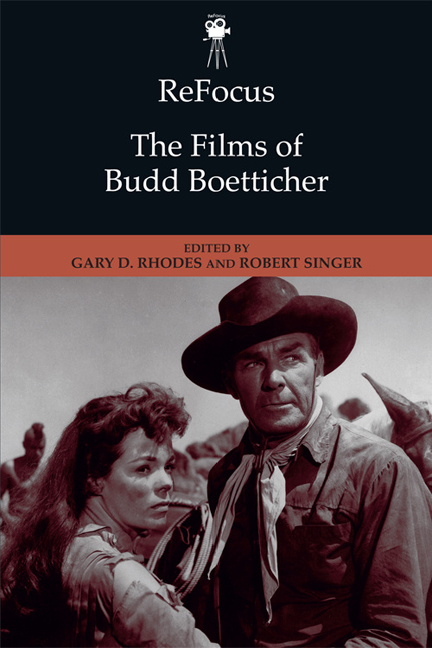Book contents
- Frontmatter
- Contents
- Notes on Contributors
- Dedication
- Introduction
- Part 1 The Non-Westerns
- Part 1 Introduction
- 1 “I never did think he was crazy”: Mystery and Criminality in Boetticher's Psychological Noirs
- 2 On Ethics and Style in Bullfighter and the Lady (1951)
- 3 Domestic Tension and Male Hysteria: The Killer is Loose (1956)
- 4 The Killer is Loose (1956) and the Televisual Dissolution of Film Noir
- 5 Adventures on the Small Screen: Boetticher, Warner Bros., and Maverick
- 6 The Signifying Heel: Boetticher's The Rise and Fall of Legs Diamond (1960)
- Part 2 The Westerns
- Index
6 - The Signifying Heel: Boetticher's The Rise and Fall of Legs Diamond (1960)
from Part 1 - The Non-Westerns
Published online by Cambridge University Press: 22 December 2017
- Frontmatter
- Contents
- Notes on Contributors
- Dedication
- Introduction
- Part 1 The Non-Westerns
- Part 1 Introduction
- 1 “I never did think he was crazy”: Mystery and Criminality in Boetticher's Psychological Noirs
- 2 On Ethics and Style in Bullfighter and the Lady (1951)
- 3 Domestic Tension and Male Hysteria: The Killer is Loose (1956)
- 4 The Killer is Loose (1956) and the Televisual Dissolution of Film Noir
- 5 Adventures on the Small Screen: Boetticher, Warner Bros., and Maverick
- 6 The Signifying Heel: Boetticher's The Rise and Fall of Legs Diamond (1960)
- Part 2 The Westerns
- Index
Summary
“The making of The Rise and Fall of Legs Diamond was an experience I'll never forget. I'd like to, but I never will.”
Budd Boetticher, When in DisgraceIn a critically revealing moment in director Budd Boetticher's gangster biopic, The Rise and Fall of Legs Diamond (1960), Legs (Ray Danton) enters an “executive meeting” of the criminal syndicate's “board of directors,” dressed to kill and obliging to none. In this sequence, composed largely of medium reverse-shots, Legs contests the flow of power and capital after the murder of the legendary syndicate organizer, Arnold Rothstein. Legs concludes that he has been left out of future underworld operations. Because of Legs's legendary capacity for violence and publicity, his fellow gangsters view Legs as a liability to the emerging corporate model. Boetticher spatially blocks this shot sequence of enterprising corporate killers with Legs separated from the others not only by his good looks and sense of humor but mostly by a palpable presence of controlled rage and self-entitlement. When Legs enters their physical space, all energy is redirected towards this lone figure.
Although this historical moment represents one of the mythic beginnings of American organized crime—“we're a nationwide syndicate now”—Legs personally belongs to a bygone era of unabated, corrupted individualism, a model of perverse male enterprise, more appropriate in the late nineteenth century. Legs belongs to nobody, not even to his sick brother or ignored wife, and certainly, not with these less dynamic gangsters whom he directly and amusingly challenges. Though this initiates the action that will lead to his death by assassins in an Albany rooming house, Legs stakes his claim but there is little sense of audience identification or empathy with this action. He is striking out on his own, taking his stand against forced incorporation but for the wrong reasons: Legs wants control of the syndicate and recognition of his stature among other gangsters. Legs Diamond is the villain in the midst of others equally debased but his is an ego demanding brutal confirmation. He is interesting and attractive but never heroic. All he needs is a black, broad-rimmed hat to match his tuxedo.
- Type
- Chapter
- Information
- ReFocus: The Films of Budd Boetticher , pp. 102 - 116Publisher: Edinburgh University PressPrint publication year: 2017

